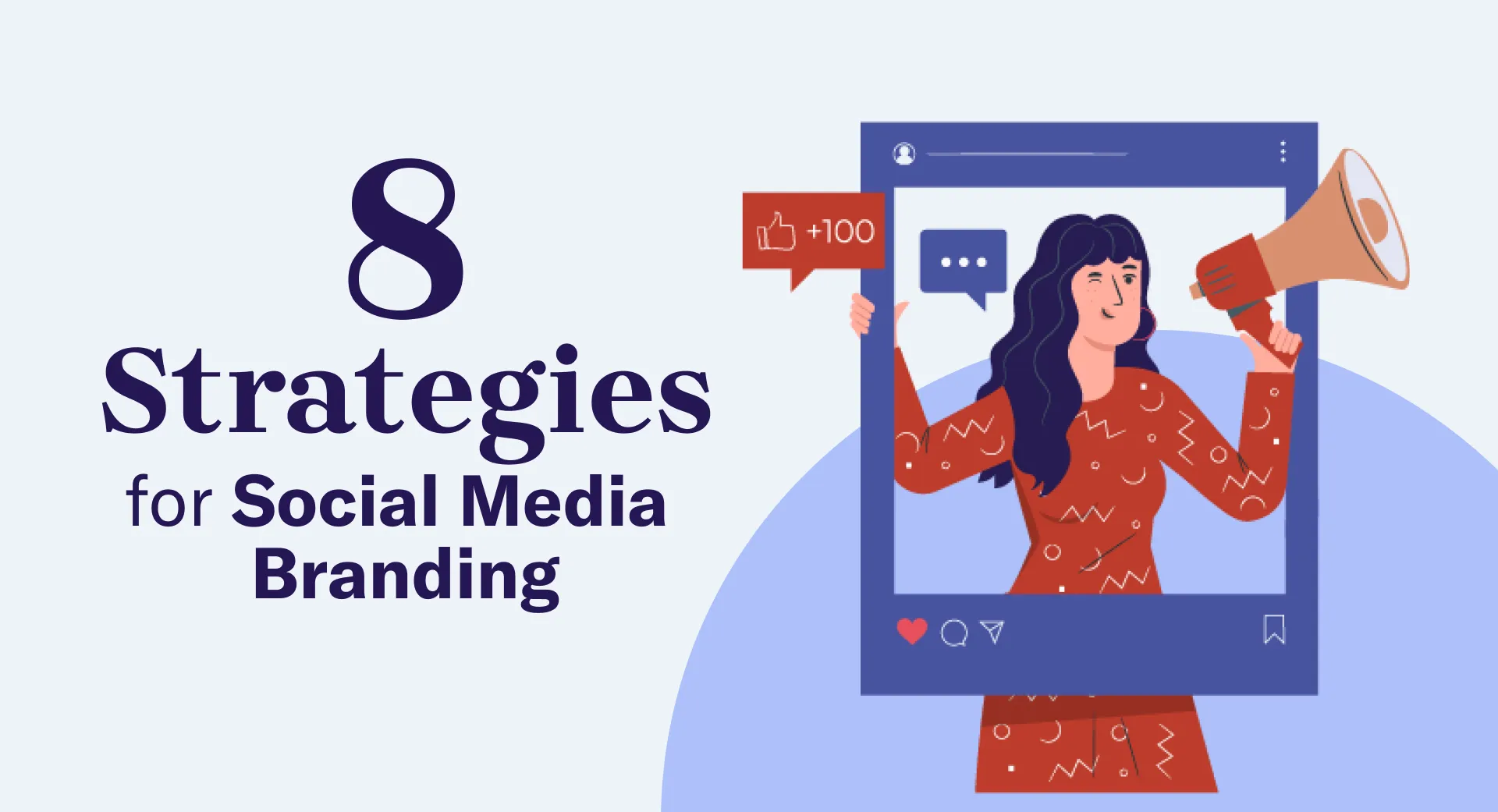
8 Excellent Strategies For Social Media Branding
Almost everyone uses social media nowadays. People use it to communicate, network, and buy or sell products and services. That’s why it’s an excellent idea for your brand to use it too. However, the social media landscape can be confusing for those not well-versed in its branding uses.
This article will break down eight strategies that you can use for social media branding and why you need to use social media in your marketing strategy in the first place. Learn more below.
Why Do You Need Social Media For Branding?
Social media provides a direct and personal way to communicate and build relationships with your clients. By providing relevant and valuable social media posts, you can portray your expertise in the field, build trust, and develop customer relationships.
A social media presence can build awareness of and engagement with your brand. It helps you to stay ahead of trends and developments in your industry and is the perfect space to differentiate yourself from the competition.
Which Social Platform Should You Use?
There are various social media platforms available, but it doesn’t mean that you have to join all of them. Each has a specific purpose, so you should only use the ones that will benefit your business. Below, the social media platforms you can use are explained.
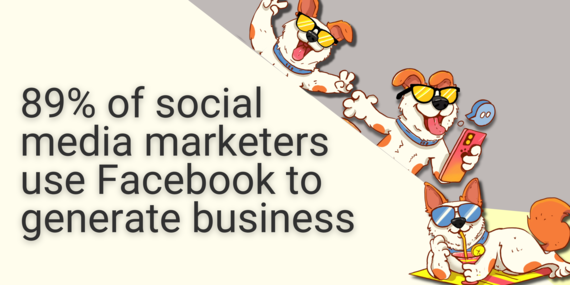
Source – Statista
1. Facebook
This social media platform is more personal than others because users typically use it to communicate with their friends and family. However, Facebook is great for advertising and cheaper than other platforms.
It is a great place to develop new business leads through targeted advertising. In fact, according to Statista, 89% of social media marketers use Facebook to generate business.
2. Instagram
Instagram relies more heavily on visuals than Facebook does. Social media users on Instagram post pictures, videos, and stories (that are only viewable for 24 hours). You can use this platform to create content that shows off your products and services as well as company events.
It is also an effective social media for establishing your branding. Posts can include your brand colors, typeface, and more. Developing consistency in branding is vital to a successful marketing strategy.
3. Twitter
Twitter is more famous for promoting special offers and sharing news. But you can also advertise on this platform. Because of the mechanisms of this social media platform, people can easily engage with your posts through likes, retweets, and replies. You can also use direct messaging to speak with customers online, answering key questions.
Twitter is an excellent social media channel for showcasing brand voice. This allows you to develop the relationship you want to have with customers. Are you relaxed and laid back? Or are your tweets more formal and business-like?
Some brands find Twitter a good place to be more relaxed, often joking with customers and other brands. While it may not be direct marketing, it builds a rapport with your customers and endears the brand to them.
Check out the Bugles marketers’ approach below:
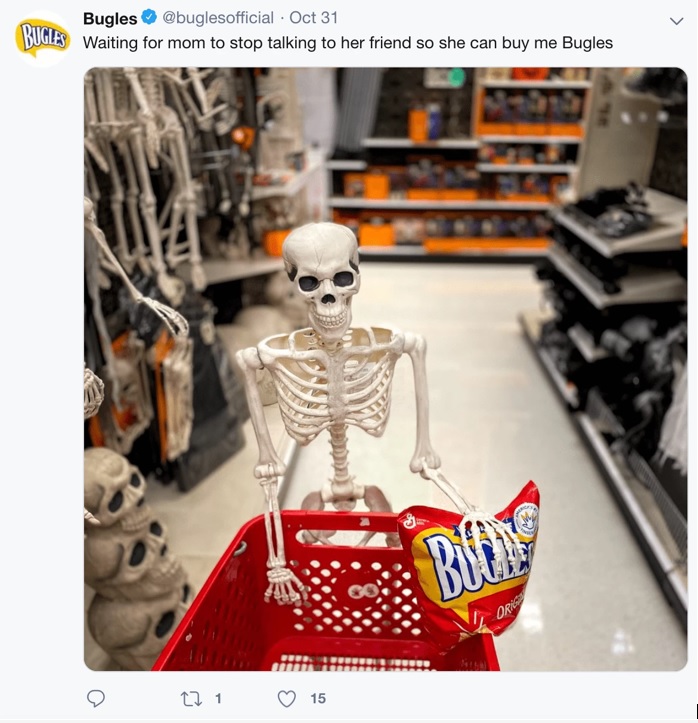

Image credit: Alidropship
4. LinkedIn
As a site with professional intention, LinkedIn allows you to build social media networks with colleagues, peers in the industry, and some prospective clients. It’s well-known for B2B (business-to-business) interactions.
Where LinkedIn differs from other platforms is the content you produce, which will have a much different target audience. It’s not a site that should be used for marketing to clients but to others in the industry.
Social media content on this platform should be designed to build relationships and supply valuable content to others in your industry. It helps to establish you as an authority in your field. It may even draw in new talent.
5. Pinterest
This social media platform allows you to share a visual story about your company. Through the pictures and videos you post on Pinterest, you can show your audience who you are as a company and the products or services you can offer.
Pinterest also provides incredibly shareable content. Your posts can be embedded into blog posts around the web, pulling people back into your profile and, by extension, your website once more.
6. YouTube
YouTube is a great place for marketing. It can increase your presence on Google and bring much website traffic in. As a video platform, the content you create can be a long or short form and should be as shareable as possible.
7. Blog
Blog posting is an older format, but it is still incredibly effective. You can create a blog on your site to build more traffic and prove your authority in your field.
You can focus on niche topics within your industry, using popular search queries to drive topics and, in turn, drive traffic to your website.
8. TikTok
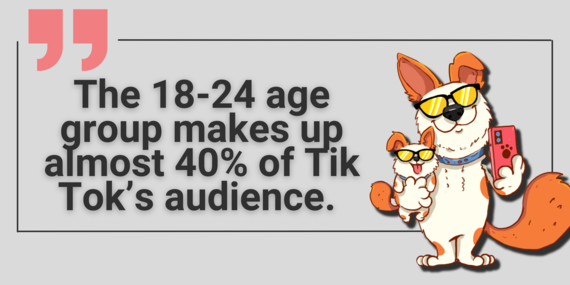
Source: Statista
TikTok is a video-based social media site. It caters to a much younger audience than other platforms and can bring in a new generation of customers. In fact, the 18-24 age group is the largest of TikTok users globally.
As of 2023, you can create TikTok videos lasting from 15 seconds to 3 minutes. However, this has changed multiple times since the app’s inception, with most updates lengthening the video times further and further.
TikTok has its own set of influencers and tends to be the starting point for many new social media trends.
9. Threads
Threads is a new Meta app connected to your Instagram account. It is easy to set up from your Instagram and automatically transfers lots of your followers over there too. Considered a clone of Twitter, Threads currently (July 2023) does not allow marketers to purchase ad space, but this doesn’t mean it can’t be used for marketing.
 The app allows users to like, repost, and reply to threads from others, but there is currently no direct messaging feature. As the app is in its early days, not much can be said for strategies for use. However, as a new app, developing a presence there as soon as possible is in your best interests.In fact, Threads accounts crossed the 100 million mark within five days of its launch, and it is currently the most downloaded free app in America. If you feel behind on your social media accounts as a brand, now is the time to get ahead of the curve.
The app allows users to like, repost, and reply to threads from others, but there is currently no direct messaging feature. As the app is in its early days, not much can be said for strategies for use. However, as a new app, developing a presence there as soon as possible is in your best interests.In fact, Threads accounts crossed the 100 million mark within five days of its launch, and it is currently the most downloaded free app in America. If you feel behind on your social media accounts as a brand, now is the time to get ahead of the curve.Strategies To Build Your Brand on Social Media
With all the platforms available, it’s challenging to develop a strategy for your social media marketing. Below, we’ve offered a step-by-step guide to give you an idea of where to start.
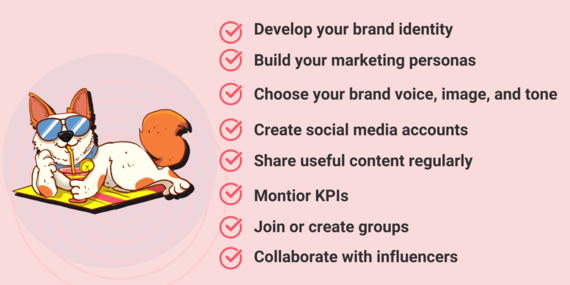
1. Develop Your Brand Identity 🪪
Brand identity is important to your marketing strategy. It is a combination of your brand values and how you communicate them to your clients. It isn’t just your logo, your tone of voice, or your brand colors. It is all of them and more.
Developing a brand identity is the first step if you want a successful marketing strategy. Your brand identity dictates the strategy; it tells you what colors to use, the tone of voice you should communicate with, and how your customers will learn your values.
You must complete this step before progressing. Consistency is a key part of a successful brand identity.
2. Build Your Marketing Personas
A marketing persona is a semi-fictional representation of your target customer or client. You may have multiple different personas, and they can change depending on the social media platform that you’re using.
For example, TikTok caters to a younger audience than Facebook and Instagram. On the other hand, LinkedIn is an older audience and is more targeted at other industry leaders rather than clients.
These distinctions will help you to optimize your efforts across each platform.
3. Choose Your Brand Voice, Image, and Tone
As part of your brand identity, you must develop a brand voice. This is how your brand will communicate with the outside world. However, this can change across social media platforms.
Brand voice is considered the unique personality that your brand displays in its communications. It is what you say to your audience. Meanwhile, the tone is how you say it. Brand image is how your audience sees your brand depending on their interactions.
To ensure that all people who are working on your social media use the same tone and brand voice, creating a guide for them is a good idea. This will help with consistency across all key platforms and ensure customers know what to expect from your brand.
Since you have various marketing personas, you should create tailored content or adjust your voice per platform.
4. Create Your Business’s Social Media Accounts 💻
If your company is not yet big, you can prioritize only a few social media platforms where your audience is typically. This will help you focus and grow your brand on these platforms. Bigger companies should have multiple accounts to ensure they can reach a much bigger audience.
For bigger companies, some strategies that you can use are the following:
- An account per branch location
- Department-specific accounts for colleges and universities
- Different marketing and customer service accounts for multiple inquiries
While it is all good and well to have a social media account, it doesn’t account for much if you don’t post regularly and encourage engagement.
5. Regularly Share Reliable and Useful Content
While you may feel that you need to post every single day, there isn’t much point in constantly posting if what you’re posting isn’t helpful. So, instead of posting mindlessly every day, devise a schedule, plan ahead, and ensure everything you post adds value.
You could post everything from company events and employee highlights to industry updates and how-to guides.
6. Create and Monitor KPIs
Key Performance Indicators (KPIs) are essential, and monitoring them can help you to understand whether your social media campaigns are effective. So, first, you have to identify which business goals are your priority. Is it brand awareness, engagement, reach, leads, or customers?
After setting your goals, you will have to choose the KPIs that you will measure. This can change depending on your platform, but some common examples are likes, follows, and impressions.
When you’re done measuring your KPIs, you need to note effective strategies and remove those that are not. Don’t be afraid to experiment and check out which methods work. KPIs can be altered along the way, depending on how your goals shift.
7. Join or Create Groups
Facebook and LinkedIn have various groups in different niches which you can join. There, you can show your expertise in your field by sharing content and engaging in conversations with other group members.
Industry groups may be full of competitors, so you can choose smaller topic-specialized groups to join instead. You may also choose to create groups within your niche. This can get a conversation going and put you in direct conversation with your customer base.
8. Collaborate With Influencers
You can work with influencers to help improve brand awareness. But you need to develop a relationship with them first before they see your expertise in your field. There are different types of influencers, which are:
- Celebrities 📸: Collaborating with celebrities is always going to cost more, but they tend to have massive audience numbers, which can be great for your brand.
- Macro Influencers: This kind of social media influencer has 100K to 1M followers. They are primarily content creators that will improve brand recognition and visibility.
- Micro–Influencers: This kind of social media influencer has 1K to 100K followers. They are less expensive and considered reliable sources in their field. They tend to be more beneficial for products that cater to a much smaller niche. If you want to use a micro-influencer, ensure they are a trusted voice within your industry.
- Employees: If your employees like your products/services and company culture, they will be excellent at promoting your brand because their friends and family will most likely believe their opinion. Employers can be highly effective on sites like LinkedIn, so encourage your employees to share posts to their personal accounts.
- Customers: People tend to believe customers’ feedback, so if they enjoy your products/services, they can spread the word about how excellent your brand is. Customers may share unboxing experiences on Instagram or talk about your products on YouTube or TikTok.
You can find influencers from different platforms, such as Facebook, Instagram, TikTok, and LinkedIn. You can use influencer marketing tools to make it easier to find them.
When you’ve identified who they are, you can analyze their networks, their types of content, and their posting habits. Identify how their audience responds to their content. Figure out what works best and what you can improve on.
Remember that working with an influencer is a partnership that can be lucrative to you both. Ensure that the influencer has the kind of audience you want to target and is trusted.
Final Thoughts
Social media is a necessity for marketing in the 21st century. It provides you with a space to speak directly to customers and offers you simple tracking software to monitor metrics, analyze your efforts, and improve them where possible.
Never before have we been able to see exactly what works and what doesn’t with marketing strategies. Utilize social media as best you can and ensure you cater your content to your audience and the platform you use for the best results.
- 8 Excellent Strategies For Social Media Branding
- Why Do You Need Social Media For Branding?
- Which Social Platform Should You Use?
- 1. Facebook
- 2. Instagram
- 3. Twitter
- 4. LinkedIn
- 5. Pinterest
- 6. YouTube
- 7. Blog
- 8. TikTok
- 9. Threads
- Strategies To Build Your Brand on Social Media
- 1. Develop Your Brand Identity
- 2. Build Your Marketing Personas
- 3. Choose Your Brand Voice, Image, and Tone
- 4. Create Your Business's Social Media Accounts
- 5. Regularly Share Reliable and Useful Content
- 6. Create and Monitor KPIs
- 7. Join or Create Groups
- 8. Collaborate With Influencers
- Final Thoughts





